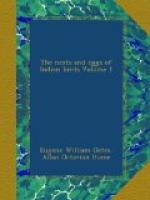Mr. J. Inglis writes from Cachar:—“This Tree-Stare is rather rare. It breeds about April in the holes of dead trees; when the young are able to fly it departs. It again returns about the middle of February.”
In Tenasserim this species was observed nesting by Mr. J. Darling, junior, who says:—“22nd March. Noticed several pairs of Calornis, with nests, in the big wooden bridge over the Kyouk-tyne Creek about 11/2 mile out of Tavoy, and also a great number of their nests in the old wooden posts of an old bridge further down the Creek.”
Mr. W. Davison, when in the Malay peninsula, took the eggs of this bird. He remarks:—“I found a few pairs frequenting some areca-palms at Laugat, and breeding in them, but only one nest contained eggs, three in number. The nest was a loose structure almost globular, but open at the top, composed externally of very coarse dry grass (lallung or elephant-grass), and lined with green durian leaves cut into small bits. The nest was too lightly put together to preserve. This nest and several other empty ones were placed at the base of the leaves where they meet the trunk.
“The three eggs obtained were slightly set, so that three is probably the normal number laid.
“I noticed several other pairs breeding at the same time in holes of a huge dead tree on Jugra Hill at Laugat, but I was unable to get at the nests.”
The eggs are quite of the Eulabes type, moderately broad ovals, more or less compressed towards the small end, occasionally pyriform. The shell firm and strong, though fine, smooth to the touch in some cases, with but little, but generally with a fair amount of gloss. The ground is a very pale greenish blue. A number of fairly large spots and blotches, intermingled with smaller specks and spots, are scattered about the large end, often forming an imperfect irregular zone, and a few similar specks and spots are scattered thinly about the central portion of the egg, occasionally extending to the small end. The colour of these spots varies; they are generally a brownish-reddish purple and a paler greyer purple, but in some eggs the spots are so thick in colour that they seem almost black. In some they are almost purely reddish brown without any purplish tinge, and some again, lying deep in the shell, are pale grey.
Six eggs measure from 0.92 to 1.1 in length, and from 0.71 to 0.76 in breadth, but the average of six eggs is 1 by 0.74.
Family STURNIDAE.
528. Pastor roseus (Linn.). The Rose-coloured Starling.
Pastor roseus (Linn.), Jerd. B. Ind. ii, p. 333; Hume, cat. no. 690.
The Rose-coloured Starling has not yet been discovered breeding in India, but Mr. Doig has written the following note on the subject, which is one of great interest. He writes from the Eastern Narra, in Sind:—




